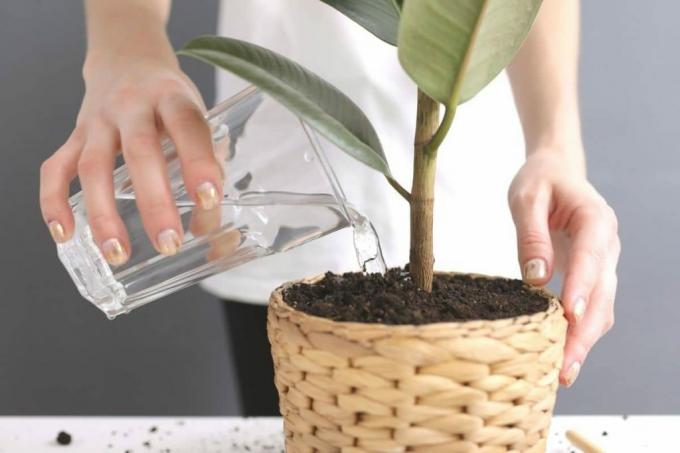
table of contents
- The rubber tree
- Watering rubber tree - 9 rules
- frequently asked Questions
Did you come across the rubber tree while looking for a decorative houseplant? That's a good choice! Proper watering is crucial for the vitality of your rubber tree. Find out what is important.
In a nutshell
- Water rubber trees only moderately
- Plant is sensitive to waterlogging
- Drainage recommended
- well suited for hydroponics
- Dust off leaves regularly
The rubber tree
The rubber tree (Ficus elastica) is one of the best-known representatives of the genus Ficus. In the fifties and sixties it was the favorite in German living rooms. Large, leathery leaves are its trademark. Gum tree leaves can be evenly dark green, reddish but also green and white patterned.
Today it can be seen again in many homes and offices. No wonder, after all, it is a perfect oxygen dispenser and is considered to be extremely easy to care for. Proper watering of your rubber tree is crucial for good development. The following applies here in particular: less is more!

Note: The rubber tree is not only pretty to look at. It is one of the best indoor air fresheners and should not be missing in any apartment. It is able to filter formaldehyde, benzene, trichlorethylene and other harmful substances from the room air.
Watering rubber tree - 9 rules
- Only water the Ficus elastica with lukewarm water. He does not tolerate cold tap water. If you can, collect rainwater to water the rubber tree.
- Do not water your rubber tree until the surface of the substrate is completely dry.
- Make sure there is good drainage. There must be no water in the saucer, because the houseplant cannot tolerate waterlogging.
Tip: Fill the bottom of the flower pot with potsherds or gravel. In this way you can prevent waterlogging.
- Choose a partially shaded or shady place in your apartment for the ficus. The soil does not dry out as quickly there and you rarely need to water. Strong sunlight can cause burns on the beautiful leaves.
- Place the rubber tree in frost-protected but cool winter quarters from October to February. 16 degrees Celsius are recommended for wintering. Water the rubber tree minimally during this time. Bring the Ficus elastica back to its location at the beginning of March and water it as usual.
- Every one to two months, put your rubber tree in the shower and gently rinse it off with lukewarm water. Alternatively, you can put it outside when it rains in summer. Make sure that the water can drain well out of the pot.

Tip: Regularly wipe the dust off the large leaves with a damp cloth. This is how photosynthesis can take place. Additionally benefits the small tree from the moisture.
- Add some green plant fertilizer to the irrigation water every two weeks during the growth phase from April to September.
- You can put the entire flower pot in a bucket of water every four weeks so that the root ball can soak up properly. The amount of water is enough for a month under normal conditions.
- The rubber tree comes from tropical regions of India and Indonesia. Spray it every now and then with water that is low in lime.
Note: Rubber trees need a sufficiently large flower pot for good development. To ensure that the plant is supplied with water and nutrients, you should repot it as soon as the pot is rooted.
frequently asked Questions
Yellow leaves are a clear sign of damage from waterlogging. This causes the roots to rot, which leads to the yellowing of the ficus leaves. Use a flower pot with drain holes. Fill in a drainage layer to prevent waterlogging. Do not water until the surface is dry. Waterlogging can also lead to the leaves falling off.
Like most ficus species, the rubber tree does well in hydroponics. This prevents waterlogging and ensures the water supply to the beautiful plant.
Check the moisture content of the soil with a finger test. Insert your finger an inch or two into the substrate. If it feels dry, it's time to water.



